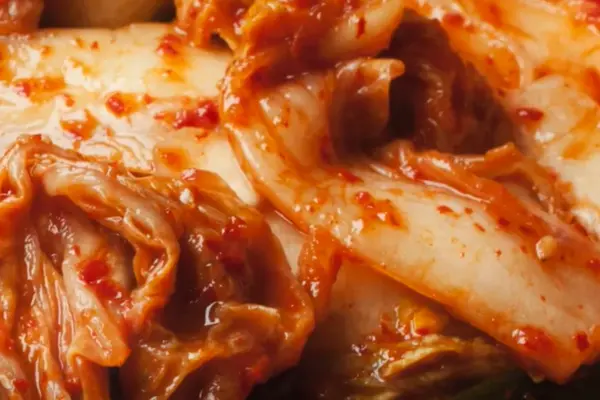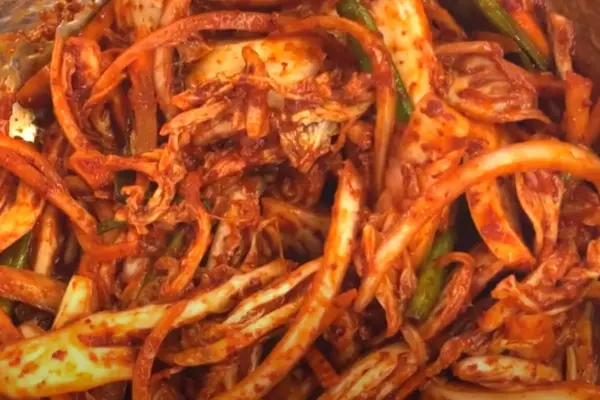Discover the Versatile World of kimchi Sauce
Have you ever wondered what gives Korean cuisine its vibrant kick and unforgettable flavor? Look no further than kimchi sauce, a staple condiment that packs a punch with its spicy, tangy essence. In this guide, exploring its ingredients, culinary uses, and the secrets to making your own at home. Whether you’re a seasoned chef or a curious foodie, understanding how to leverage kimchi sauce in your cooking can transform your dishes from mundane to mesmerizing. Join us as we uncover the diverse applications of this beloved Korean condiment and learn why it’s cherished by gourmets worldwide.

What is K Sauce?
Definition and Composition
is a flavorful Korean condiment made primarily from fermented cabbage and a variety of spices, including chili pepper, garlic, ginger, and often fish sauce. This sauce is derived from the traditional side dish, kimchi, which is a cornerstone of Korean cuisine. The sauce variant condenses the bold flavors of kimchi into a versatile and easy-to-use liquid form that can enhance any dish with a burst of umami and heat.
Culinary Uses of Kimchi Sauce
In the kitchen,is as versatile as it is vibrant. It’s commonly used as a marinade to give meats a spicy, tangy twist or as a salad dressing to add a kick to fresh greens. You can also stir it into stews and soups to deepen their flavor or drizzle it over rice bowls for an extra zing. The adaptability of kimchi sauce makes it a must-have for anyone looking to infuse their dishes with the rich, complex flavors of Korean cooking.
By incorporating k sauce into your culinary repertoire, you open the door to an array of flavor-packed possibilities. Stay tuned as we next explore how to create your own k sauce at home, ensuring you can bring the essence of Korean flavor to your table anytime.
Making Kimchi Sauce
Key Ingredients
To whip up your own batch of homemade kimchi sauce, you’ll need a few essential ingredients that capture the essence of traditional kimchi while offering ease of use in a sauce form. Here’s what you’ll typically need:
- Korean chili flakes (Gochugaru): This provides the iconic red color and spicy kick.
- Garlic and Ginger: Both are crucial for their aromatic and flavor-enhancing properties.
- Fish Sauce: Adds depth with its savory, umami richness.
- Sugar: Balances the acidity and heat with a touch of sweetness.
- Rice Vinegar: Introduces a mild acidity that brightens the overall flavor of the sauce.
- Salt: Essential for seasoning and helps in the fermentation process.
Each of these ingredients contributes to the complex flavor profile of kimchi sauce, making it a multi-dimensional addition to any dish.
Step-by-Step Recipe
Creating k sauce at home is surprisingly straightforward. Here’s how you can do it:
- Prepare the Base: In a blender, combine 1 part water with 1 part rice vinegar. Add a handful of chopped garlic cloves, a similar amount of ginger, and a few tablespoons of sugar and salt to taste. Blend until smooth.
- Add Heat and Flavor: To the blended mixture, incorporate the Korean chili flakes, adjusting the quantity based on how spicy you like your sauce. Blend again until the chili flakes are well incorporated and the sauce turns a vibrant red.
- Ferment (Optional): For a more authentic flavor, let the sauce ferment. Pour it into a jar, seal it loosely, and leave it at room temperature for 1-2 days before transferring it to the refrigerator.
- Final Touches: Once fermented, stir in a generous splash of fish sauce for added depth. Taste and adjust seasoning if necessary.
This homemade kimchi sauce can be stored in the refrigerator for up to a month, allowing the flavors to meld and develop over time.
By making your own ki sauce, you not only gain control over the ingredients and their quality but also tailor the flavor to suit your palate perfectly. In the next section, we will delve into the nutritional value of k sauce and explore the health benefits it offers, linking to resources like Healthline – Benefits of Probiotic Foods for those interested in the probiotic aspects of fermented foods.

Nutritional Value
Health Benefits
much like its base ingredient kimchi, is lauded for its numerous health benefits, which are largely derived from the fermentation process and its rich array of ingredients. Here are some key health benefits associated with kimchi sauce:
- Probiotics: The fermentation process encourages the growth of beneficial bacteria, known as probiotics, which can aid in digestion and enhance gut health. These probiotics help balance the gut microbiome, which is crucial for overall health.
- Vitamins and Minerals: Kimchi sauce is a good source of vitamins such as Vitamin A, Vitamin C, and some B vitamins. It also contains minerals like iron, calcium, and selenium, contributing to a well-rounded nutritional profile.
- Antioxidants: Ingredients like garlic, ginger, and chili flakes provide antioxidants that help reduce oxidative stress in the body, potentially lowering the risk of chronic diseases.
Caloric Content and Nutritional Breakdown
While the exact nutritional content can vary based on the specific recipe and proportions of ingredients used, k sauce generally offers a low-calorie option packed with nutrients. Here’s a basic breakdown for a typical serving:
- Calories: Approximately 25-30 calories per tablespoon
- Carbohydrates: About 5-6 grams, largely from natural sugars and fibers
- Proteins: Minimal protein content
- Fats: Very low fat, as kimchi S typically does not contain added oils
is an excellent choice for those monitoring their calorie intake but still seeking flavor and nutritional benefits in their diet. Its low-calorie nature, combined with a host of beneficial micronutrients and bioactive compounds, makes it a healthful addition to various dishes.
In the following section, we’ll explore some of the top commercial kimchi sauce products available on the market, helping you understand what to look for when choosing a store-bought version to ensure you’re getting a product that’s not only tasty but also aligns with healthful eating practices.

Commercial Products
Review of Popular Brands
When shopping for kimchi sauce, you’ll find a variety of options available on the market. Each brand offers its own take on this traditional Korean condiment, with variations in flavor, spice level, and ingredients. Here are some popular brands that are well-regarded for their quality and taste:
- Otafuku K Sauc: Known for its authentic flavor, this brand offers a k sauce that is rich in taste and perfect for marinades or as a spicy topping.
- Mother-in-Law’s Kimchi Sauce: This brand is celebrated for its traditional and handcrafted approach to kimchi and extends this craftsmanship to their k sauce, which is available in mild and spicy versions.
- Chung Jung One: A major player in Korean condiments, Chung Jung One provides a kimchi sauce that is versatile and well-suited for cooking, adding a robust flavor to dishes.
What to Look for When Buying
Choosing the right k sauce can enhance your cooking and allow you to enjoy the authentic flavors of Korean cuisine.
- Ingredients: Look for a sauce with high-quality, natural ingredients without unnecessary additives or preservatives. Traditional ingredients like Korean chili peppers, garlic, and fermented base should be high on the list.
- Authenticity: Opt for brands that adhere to traditional Korean recipes for the most authentic flavor.
- Dietary Considerations: Check labels for allergens or dietary restrictions, such as gluten-free or vegan, to ensure the sauce meets your dietary needs.
- Flavor Profile: Depending on your taste preferences, you might choose a milder or spicier version. Some brands also offer variations with added ingredients like extra garlic or special herbs.
When integrating kimchi sauce into your kitchen, these commercial products can be a convenient way to add traditional Korean flavors to your meals without the need for homemade preparations. By understanding what each brand offers and what to look for, you can select a kimchi sauce that enhances your dishes while aligning with your health and dietary preferences.
In the next section, we’ll dive into some creative and delicious recipes that utilize k sauce, demonstrating its versatility in everyday cooking.
Cooking with Kimchi Sauce
Recipes Using Kimchi Sauce
K sauce is incredibly versatile and can be used in a myriad of culinary creations. Here are a few recipes that highlight the adaptability and flavor-enhancing properties of kimchi sauce:
- Kimchi Fried Rice: Boost the flavor of this classic Korean dish by stirring in a tablespoon or two of kimchi sauce while frying your rice. Add vegetables, shrimp, or chicken for a hearty meal.
- Kimchi Sauce BBQ Marinade: Mix k sauce with a little brown sugar, soy sauce, and sesame oil to create a marinade that’s perfect for beef, chicken, or pork. The umami-rich sauce will infuse the meat with intense flavors.
- Spicy Kimchi Noodles: Toss your favorite noodles with kimchi sauce, fresh vegetables, and strips of pan-fried tofu for a quick and spicy meal. Garnish with sesame seeds and sliced green onions.
Tips for Cooking
To make the most out of cooking with kimchi sauce, keep these tips in mind:
- Balance the Flavors: K sauce is potent and can dominate other flavors easily. Start with small amounts and adjust according to your taste preferences.
- Pair with Complementary Ingredients: Ingredients like sesame oil, garlic, and ginger complement the bold flavors of k sauce. Use these to build a harmonious dish.
Cooking with kimchi sauce allows you to bring a touch of Korean cuisine to your table with ease. Its spicy, tangy characteristics work well in various dishes, from marinades to stir-fries, making it a valuable condiment in any cook’s pantry.
In the upcoming section, we’ll compare kimchi sauce to other popular condiments and traditional kimchi, helping you understand when and how to use each to best enhance your dishes.
Comparisons to Other Condiments
Kimchi sauce is a unique and flavorful addition to the world of condiments, but how does it stand up against other popular options? This comparison will help you understand when to best use k sauce versus other condiments like Sriracha or traditional kimchi.
Kimchi Sauce vs. Sriracha
- Flavor Profile: K sauce offers a complex flavor that includes tanginess from fermentation, which is absent in Sriracha.
- Spice Level: While both condiments bring heat, Sriracha tends to have a more consistent and pronounced spice level.
- Uses: Sriracha is often used as a general hot sauce, ideal for splashing over meals to add spice.
K Sauce vs. Traditional Kimchi
- Consistency and Application: Traditional kimchi is a chunky, fermented vegetable dish, while kimchi sauce is a liquid condiment.
- Flavor Intensity: usually has a concentrated flavor, designed to impart strong kimchi taste in a more usable form , and adds texture as well as flavor to dishes.
- Culinary Flexibility: While both can be used in cooking, traditional kimchi adds bulk and texture that k sauce does not. Conversely, kimchi sauce can be used in a broader range of culinary applications, from drizzling over pizza to spicing up a Bloody Mary.
Understanding these distinctions can help you choose the right ingredient for your cooking needs, whether you’re looking for a versatile sauce to enhance your recipes or a robust condiment to complement your dishes.
FAQs Section
Can kimchi sauce be made vegan?
Yes, k sauce can easily be made vegan by ensuring that no fish sauce or other animal products are included in the recipe. Many store-bought vegan kimchi sauces use seaweed or miso as substitutes to provide umami flavors typically contributed by fish sauce.
How long does homemade kimchi sauce last?
Homemade kimchi can last in the refrigerator for up to a month when stored properly in an airtight container. The fermentation process may continue slowly in the fridge, which can change the flavor over time, often deepening the tanginess.
Is kimchi sauce gluten-free?
Not all k sauces are gluten-free, as some may contain soy sauce or other ingredients that include gluten. Always check the label if purchasing commercial kimchi sauce, or ensure that all ingredients used in a homemade recipe are gluten-free, such as using tamari instead of traditional soy sauce.
Can I use kimchi sauce for cooking, or is it just a condiment?
is incredibly versatile and can be used both as a condiment and as a cooking ingredient. It works well as a marinade for meats, a flavorful addition to sauces and stews, or even as a spicy base for salad dressings.
What are the best dishes to pair with kimchi sauce?
Kimchi sauce pairs well with a variety of dishes including grilled meats, tofu, noodles, and rice dishes. It can also be used to spice up vegetables, soups, and can even be incorporated into Western dishes like burgers and sandwiches for an Asian twist.
Does kimchi sauce need to be refrigerated?
Yes, kimchi sauce should be refrigerated after opening to preserve its freshness and extend its shelf life. Even homemade k sauce should be stored in the refrigerator immediately after preparation.
